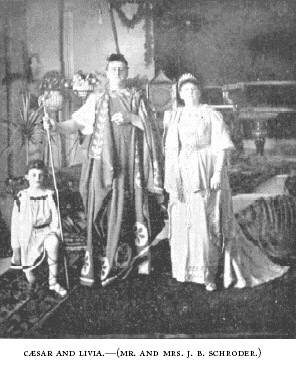In his hand he carried a short sword. If the Retiarius made a bad or unsuccessful cast with the net, he ran off pursued round the arena by the Mirmillo (who was also called a Secutor, or pursuer), and tried to gather up his net for a fresh cast. I do not know w h a t the result of the combats between Retiarii and Mirmillones usually was in the Roman amphitheater, but at the Olympic reproduction, the Retiarius almost invariably succeeded in keeping off his adversary , whom he finally enmeshed and dispatched.  The Mirmillones wore a Gallic helmet, with the figure of a fish as a crest, and are supposed to have been originally Gauls. |
The "Roman Holiday" was brought to a close with an alleged chariot race. Two lieutenants of the United States Army drove, and though they and their teams looked very well it was impossible in a space not quite three hundred feet long to get up even a semblance of a contest. It seems regrettable that the management should have included in the list of sports a feature almost certain to border closely upon the farcical. Yet if it was done because it was believed that it would be popular it succeeded, for popular it certainly was, however absurd from the sportsman's point of view. It will be seen that the sports and contests exhibited were all Roman, except the Pentathlon and Pancratium, the former of which was a reproduction of the contests at the famous Olympic games held every four years at Olympia. It may be well to refer to the financial side of an entertainment which from an artistic point of view was a very great success. Two thousand season tickets, admitting two persons to each performance, were issued at a price of five dollars each. But, unfortunately, large as the space was made to appear by the adroit painting of the scenery the seating capacity was only three thousand two hundred , out of which number four hundred seats were taken up by Cæsar and his court, the Senators, Vestal Virgins and the Band. The last was no "infinitesimal Teutonic agglomeration," but a decidedly big Roman Band. Thus only two thousand eight hundred seats were left to accommodate the holders of two thousand season tickets, each admitting two persons. If each ticket was used to its full capacity one thousand two hundred persons went without seats. Further, the entire novelty of the spectacle and the expenses connected with so varied an entertainment caused the outlay to be much greater than was at first contemplated. Besides the high cost of transforming the Pavilion into a Roman Circus, a complete array of Roman dresses, weapons, armor and chariots had to be provided, so that seven thousand dollars was spent in the purchase of properties, which would be very useful on any second attempt to |
page 1 | page 2 | page 3 | page 4 | page 5 | page 6 | page 7 | page 8